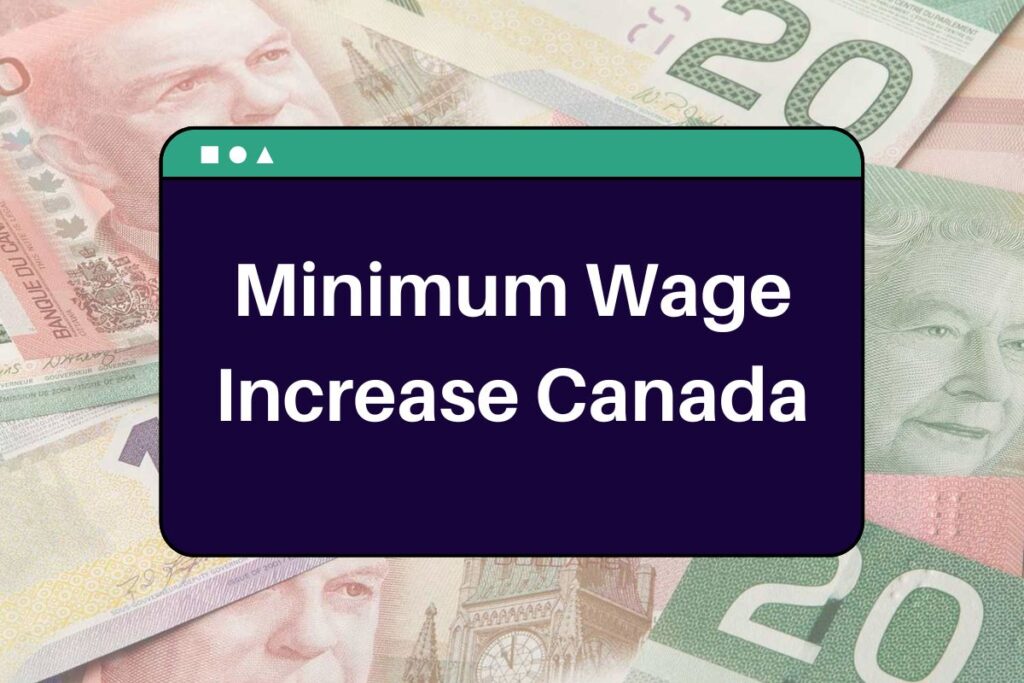Provinces and territories in Canada are adjusting their Minimum Wage Increase Canada in response to the ongoing increase in living expenses. These pay raises are intended to help workers stay up with inflation and guarantee fair pay across industries. Although Canada has a federal minimum wage, it mostly applies to workers at companies that are subject to government regulation, such banks, postal services, and federal Crown corporations.
However, the power to set a minimum wage for workers under their control rests with each province and territory. By 2025, a number of provinces have raised their minimum wage rates due to inflation and the growing cost of living. A detailed explanation of the changes, their implementation date, and their effects on workers across the country is given in this post.
Minimum Wage Increase Canada
In 2025, Canada plans to implement large minimum wage hikes in a number of provinces and territories in an effort to solve the persistent problems brought on by inflation and growing living expenses. These adjustments show a national commitment to upholding economic stability while guaranteeing workers receive fair remuneration. In order to reflect contemporary economic changes and societal demands, Canada’s minimum wage laws are regularly reviewed and updated.
The need to guarantee that workers, regardless of the kind of job they do, get fair pay for their labor is the foundation of Canada’s minimum wage policy. Many provinces will raise their minimum wage rates in 2025, resulting in major wages changes for workers across Canada. The goal of this pay raise is to assist workers in maintaining their quality of living in the face of growing expenses as part of a larger national reaction to inflation. In an effort to guarantee that workers can keep up with the cost of living, some provinces have lately raised the minimum wage. These little changes are meant to alleviate these financial strains.
List of Provinces That will get Increased Wages This year
Every Canadian province and territory sets its own minimum wage in accordance with local laws, inflation, and economic situations. The new minimum wages for 2025 have already been announced in a number of provinces. These adjustments, which will be implemented on several days throughout the year, will guarantee that workers in Canada get fair pay in line with the rising cost of living. A thorough analysis of the provinces raising their minimum wages in 2025 is given below.
| Name of Province/Territory | Current Min. Wage | Exp. Increase | Starting Date |
|---|---|---|---|
| New Brunswick | $15.30 | $15.77 | April 1, 2025 |
| Nova Scotia | $15.00 | $15.40 | April 1, 2025 |
| Newfoundland & Labrador | $15.60 | $15.91 | April 1, 2025 |
| Yukon | $17.59 | $17.97 | April 1, 2025 |
| Quebec | $15.75 | Updating soon | May 1, 2025 |
| British Columbia | $17.40 | Updating soon | June 1, 2025 |
| Northwest Territories | $16.05 | Updating soon | September 2025 |
| Ontario | $17.20 | $17.82 | October 1, 2025 |

Understanding Minimum Wage System in Canada
The lowest hourly compensation that companies are required by law to give their employees is known as the minimum wage. Each province and territory sets its own minimum wage to suit local economic realities, while the federal government sets a base rate for workers in federally regulated areas like banking and postal services. Usually, increases to the minimum wage are correlated with the Consumer Price Index (CPI), which tracks changes in the cost of necessities and inflation. With the help of this system, incomes are guaranteed to keep pace with growing living expenditures.
Canada’s Current Minimum Wage
The federal minimum wage exists, but it only applies to workers who work for federally regulated companies including banks, postal services, federal Crown corporations, and interprovincial transit. The GOC sets it every year and adjusts according to CPI. Many provinces and territories make up the nation, and each has its varying tariffs and they differ significantly depending on local regulations, inflation, and living expenses. It is made for its employees by each province or territory.
The Canadian minimum wage is expected to be around $17.30 per hour as of 2025. However this differs greatly across provinces and areas. To guarantee that wages reflect inflation and COL, the federal government bases rate increases on CPI. So to assist workers in keeping up with inflation, the federal minimum wage will increase soon.
Why Minimum Wages are Increasing in 2025?
Canada’s minimum wage has increased, primarily due to inflation and the growing cost of living. Living expenses, housing costs, and food prices are all rising, making it harder for workers to satisfy their basic necessities. The Canadian federal and provincial governments are increasing wages to allow workers to keep their buying power in response to this economic strain.
Additionally, as many low-paid workers have been facing stagnating wages for years, especially in the service, retail, and hospitality industries, these wage hikes are intended to combat the growing income disparity. In order to help the workers financially and guarantee a more fair distribution of income, the government has decided to raise the minimum wage.
Why These Increases Matter?
- These wages increases assist workers in maintaining their buying power in the face of a continually growing cost of living.
- Increased pay guarantees that employees, particularly those in lower-paying positions, have enough money to pay for necessities like housing, food, and transportation.
- Businesses may recruit and retain workers and create a more stable workforce by increasing the minimum wage.
- Better living circumstances, healthcare, and education are all made possible by higher pay, which enhances workers’ general well-being.
| Official Website | Click Here |
| Homepage | OFSSBihar.in |



